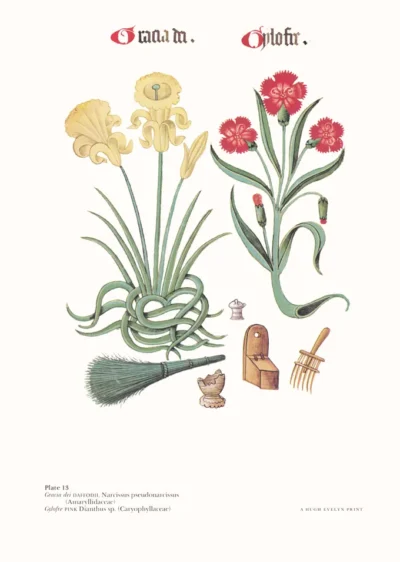Asphodel & Wood Avens
£20.00
Asphodel and Wood Avens (scroll down for a more detailed Description)
Published 1972 by © Hugh Evelyn Limited; drawn around 1525, these images were finished in gouache and watercolour (see description here)
Size: c. 23 x 33.5 cm [9 ″ x 13 ¼ ″] may vary slightly from printers’ cut 50 years ago
Printed on high white matt cardstock 144 g/sm2.
Print is STANDARD size – shipping is the same for 1 to 10 prints (based on largest print size in your order) – see Shipping & Returns.
In stock
Description
Affadille: The name Affadille is an old name for the Daffodil. Asphodelus is a genus of mainly perennial plants first described in 1753. The genus is native to temperate Europe, the Mediterranean, Africa, the Middle East, and the Indian Subcontinent. We have one small native species, the Bog Asphodel, which occurs in wetlands and is common over most of the British Isles. The specific name ossiphragum literally means ‘bone breaking’ and this refers to the supposed effects upon sheep and cattle of eating this plant. These are related to boggy ground rather than the flora, since this species prefers to grow on lime-free soils which would provide only relatively small amounts of the calcium salts needed for the healthy growth of bones. In the Shetland Islands this plant has been used as a substitute for Saffron in medicine or dyeing, and in the seventeenth century Lancashire women used to gather it from the moors to use as a hair dye, hence its local name in those parts: Maiden’s Hair. Avence: Geum urbanum, also known as wood avens, herb Bennet, colewort and St. Benedict’s herb (Latin herba benedicta), is a perennial plant in the rose family (Rosaceae), which grows in shady places in Europe and the Middle East. Herb Bennett is a native plant, deriving its name from the French herb beneite, ‘blessed herb’, derived from the Latin herba benedicta. There was an old saying that ‘when the root is in the house, the Devil cannot enter’. Nicholas Culpeper (1) said, ‘a delicate flavour and taste’ that ‘comforteth the heart’, their scent is like cloves (the German name for the plant is Nelkenwurz – ‘clove-root’). This fragrance repelled evil and was recommended by Gerard (2) for ‘keeping garments from being eaten with Mothes’ and ensuring they smell fragrant. The roots, boiled in pottage or broth, could be used for upset-stomachs or attacks of wind. An infusion of herb or root is still said to be restorative in cases of weakness and debility, and helpful in case of diarrhoea and sore throat. Arber (3) has a woodcut of this species from Brunfels’ (4) Herbarium.
Additional information
| Weight | 0.0094 kg |
|---|---|
| Dimensions | 24 × 33.7 cm |





